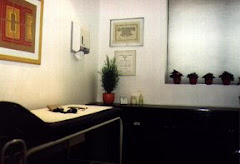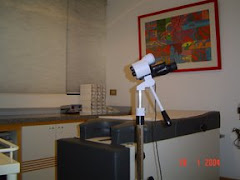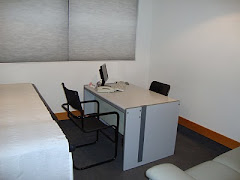
Um "alarme de bexiga" pode vir a ajudar milhões de homens e mulheres no Reino Unido, com o problema de incontinência urinária. O aparelho é monitorizado por computador, ficaria fixo por sucção na região inferior do abdome, emitiria um baixo sinal sonoro desencadeado pela elevação da temperetura com o acúmulo de urina no interior da bexiga. Seria útil nos casos de incontinênica por hiper-distensão da bexiga ou nos casos de urgincontinência, podendo ser usado com discreção por baixo das vestimentas. O aparelho chamado de Sense Urine, vem sendo testado em Israel.
Veja o artigo publicado no U.K. Daily Mail:
"The tiny alarm that can save embarrassment and beat incontinence"
By ROGER DOBSON
A bladder "alarm" could help millions of British women and men who suffer from incontinence.
The computer-controlled device, which is worn over the abdomen, detects when the bladder is getting full and sounds a discreet alarm.
The wearer is then able to go to the loo before there is an accidental leakage.
Incontinence affects up to six million people in the UK, and it's twice as common in women as men.
When it's full, the bladder contains an average of 350ml of urine. Normally, the bladder sends messages to the brain when it needs emptying.
The brain then tells the pelvic floor muscles to relax, and the sphincter (the opening at the bladder neck) then opens. The bladder muscles then tighten and force the urine out.
But in those with incontinence, the muscles or nerves do not work properly to control the bladder. As a result, the brain doesn't get the messages that it is full.
Causes of incontinence can include pregnancy, being overweight, untreated diabetes, weakening of muscles with age and bladder infections such as cystitis.
Treatment is usually with pelvic floor exercises, lifestyle changes and drugs - if none of these work, patients may be offered surgery.
Options include an operation to lift the bladder neck, or injections of synthetic material into the bladder neck to strengthen it.
The new device, the SenseUrine, is designed to give sufferers control over their incontinence - although it could also possibly treat the problem, too.
It is targeted at people suffering from urge incontinence (where the bladder suddenly empties completely) or overfill incontinence (where weak muscles mean you cannot empty the bladder fully).
The device is less than half an inch thick and two inches square, and is attached by suction to the abdomen over the bladder area, where it is worn all the time under clothing.
Ringing in changes for incontinence: An alarm could alert sufferers to full bladders
It contains a computer chip that measures and records minute temperature changes in the skin. It is based on the principle that bladder temperature rises as it fills because the liquid temperature is higher than that of the bladder tissue.
The device calculates how full the bladder is at any time. When it is close to being full, and the risk of leakage high, it vibrates or sounds a low-pitched yet audible alarm, which can be stopped by taking the device off.
This allows the wearer time to prepare and empty the bladder as normal without problems.
The idea is that it will help sufferers manage their incontinence, but researchers believe it could also help to retrain the bladder so that it works more effectively.
"By using this device, incontinence will be adequately managed so that bladder control problems need not interfere with a healthy, productive and active lifestyle," says Dr Yuli Lozinski, chief executive of developers Sense Tech Urology.
"The device is non-invasive, compact and easy to use."
The developers say the device could also be used by children who wet the bed - around 15 per cent of five-year-olds have this problem.
Lesley Woolnough, executive director of Incontact, the incontinence charity, says: "We wholeheartedly support any innovation that may ultimately benefit the patient."
The SenseUrine is currently being tested on patients at the Rambam Medical Centre in Israel, and is expected to be available over the next 12 months, priced around £50.
However, it is not designed to help with stress incontinence, where a small amount of urine leaks from the bladder regardless of whether or not it is full.
The computer-controlled device, which is worn over the abdomen, detects when the bladder is getting full and sounds a discreet alarm.
The wearer is then able to go to the loo before there is an accidental leakage.
Incontinence affects up to six million people in the UK, and it's twice as common in women as men.
When it's full, the bladder contains an average of 350ml of urine. Normally, the bladder sends messages to the brain when it needs emptying.
The brain then tells the pelvic floor muscles to relax, and the sphincter (the opening at the bladder neck) then opens. The bladder muscles then tighten and force the urine out.
But in those with incontinence, the muscles or nerves do not work properly to control the bladder. As a result, the brain doesn't get the messages that it is full.
Causes of incontinence can include pregnancy, being overweight, untreated diabetes, weakening of muscles with age and bladder infections such as cystitis.
Treatment is usually with pelvic floor exercises, lifestyle changes and drugs - if none of these work, patients may be offered surgery.
Options include an operation to lift the bladder neck, or injections of synthetic material into the bladder neck to strengthen it.
The new device, the SenseUrine, is designed to give sufferers control over their incontinence - although it could also possibly treat the problem, too.
It is targeted at people suffering from urge incontinence (where the bladder suddenly empties completely) or overfill incontinence (where weak muscles mean you cannot empty the bladder fully).
The device is less than half an inch thick and two inches square, and is attached by suction to the abdomen over the bladder area, where it is worn all the time under clothing.
Ringing in changes for incontinence: An alarm could alert sufferers to full bladders
It contains a computer chip that measures and records minute temperature changes in the skin. It is based on the principle that bladder temperature rises as it fills because the liquid temperature is higher than that of the bladder tissue.
The device calculates how full the bladder is at any time. When it is close to being full, and the risk of leakage high, it vibrates or sounds a low-pitched yet audible alarm, which can be stopped by taking the device off.
This allows the wearer time to prepare and empty the bladder as normal without problems.
The idea is that it will help sufferers manage their incontinence, but researchers believe it could also help to retrain the bladder so that it works more effectively.
"By using this device, incontinence will be adequately managed so that bladder control problems need not interfere with a healthy, productive and active lifestyle," says Dr Yuli Lozinski, chief executive of developers Sense Tech Urology.
"The device is non-invasive, compact and easy to use."
The developers say the device could also be used by children who wet the bed - around 15 per cent of five-year-olds have this problem.
Lesley Woolnough, executive director of Incontact, the incontinence charity, says: "We wholeheartedly support any innovation that may ultimately benefit the patient."
The SenseUrine is currently being tested on patients at the Rambam Medical Centre in Israel, and is expected to be available over the next 12 months, priced around £50.
However, it is not designed to help with stress incontinence, where a small amount of urine leaks from the bladder regardless of whether or not it is full.











Nenhum comentário:
Postar um comentário